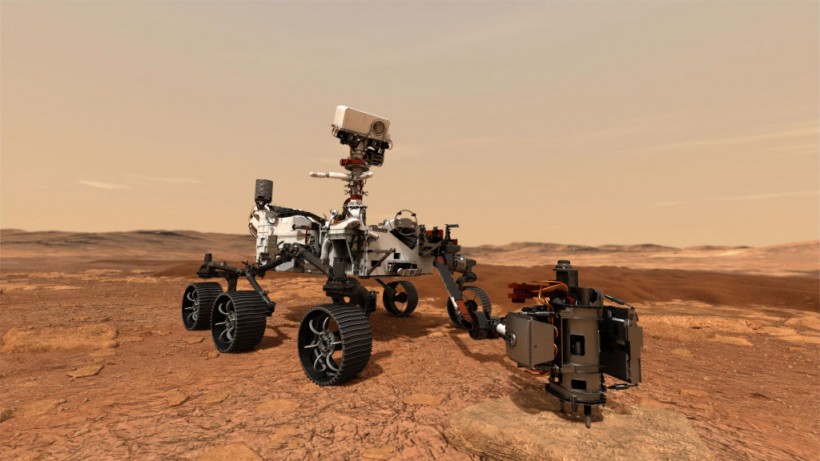NASA's Perseverance rover has made history by generating enough oxygen on Mars to support an astronaut for three hours using the Mars Oxygen In-Situ Resource Utilization Experiment (MOXIE) device, a groundbreaking achievement in space exploration.
Over the course of two years following its landing on Mars in February 2021, the MOXIE device diligently and periodically converted the planet's abundant carbon dioxide into life-sustaining oxygen.

In this concept illustration provided by NASA, NASA's Perseverance (Mars 2020) rover uses its drill to core a rock sample and will store them in sealed tubes on the planet's surface for future missions to retrieve in the area known as Jezero crater on the planet Mars.
MOXIE Extracts Oxygen From Martian Air
NASA reported that the microwave-sized MOXIE device has successfully generated 4.3 ounces (equivalent to 122 grams) of oxygen. This amount, though seemingly small, is equivalent to what a small dog breathes over a ten-hour span. This accomplishment has ignited hope among scientists that one day, human life could be sustained on the harsh Martian terrain.
Trudy Kortes, the director of technology demonstrations at NASA Headquarters, expressed pride in supporting MOXIE's groundbreaking technology, which can potentially convert local resources into essential supplies for future Mars exploration missions. This advancement brings us a step closer to a future where astronauts can "live off the land" on the Red Planet.
Mars boasts an atmosphere rich in carbon dioxide, constituting 95% of its composition. MOXIE conducted 16 experiments, extracting oxygen atoms from carbon dioxide through a zapping process. The oxygen was meticulously analyzed for purity and then securely stored within a capsule, while the remaining components were released as carbon monoxide.
Furthermore, these oxygen-extraction devices hold promise not only for providing breathable air for future Mars settlers but also for producing rocket fuel.
NASA's Deputy Administrator, Pamela Melroy, emphasized that MOXIE's impressive performance demonstrates the feasibility of extracting oxygen from Mars' atmosphere, which could serve as a valuable resource for breathable air and rocket propellant for astronauts in the future.
Developing such technologies is pivotal for establishing a sustainable presence on the Moon, nurturing a robust lunar economy, and supporting the initial human exploration efforts on Mars.
READ ALSO: NASA's Moxie Aims to Make Air in Mars Breathable Instead of Transporting Oxygen from Earth
More Hurdles Ahead
MOXIE's breakthrough experiment is a noteworthy step towards sending humans on the Red Planet. However, substantial health challenges still obstruct the establishment of a viable Mars colony.
The planet's severe cold, averaging around -80 degrees Fahrenheit (-62 degrees Celsius), would prove fatal without protective gear due to its low atmospheric pressure. Furthermore, the absence of an ozone layer exposes residents to cancer-causing radiation, and the journey itself results in significant bone-density depletion.
As of now, humans' closest interaction with Mars remains through rovers like Perseverance. A pivotal component of NASA's $2.7 billion Mars 2020 mission, alongside the Curiosity rover, endeavors to uncover signs of ancient Martian life by amassing rock samples for eventual return to Earth. The mission also features the Ingenuity helicopter, which has successfully completed 57 flights over the Martian surface.
Nonetheless, the insights gained from the MOXIE experiment pave the way for the development of a comprehensive system, encompassing an oxygen generator capable of liquefying and storing oxygen. The subsequent significant phase involves conducting trials of various technologies on Mars, such as tools and materials for habitats, to advance exploration efforts further.
RELATED ARTICLE: NASA's MOXIE Sets New Oxygen Production Record, Fueling Hopes for Future Missions
Check out more news and information on Mars on Science Times.














